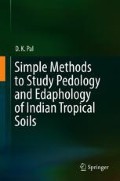Abstract
In Indian sub-continent, Vertisols in humid tropical (HT), sub-humid moist (SHM), sub-humid dry (SHD), semi-arid moist (SAM), semi-arid dry (SAD) and arid dry (AD) climatic environments indicate their occurrence in a climosequence. The soils show a change in their morphological, physical, chemical and micromorphological properties due to change of climate from humid to arid during the Holocene period. Formation of pedogenic CaCO3 (PC), illuviation of clay and the development of subsoil sodicity are concurrent, contemporary and active pedogenetic processes operating during the climate change of the Holocene period. These processes impaired the hydraulic properties of soils in general, and in soils of drier climates in particular. As a result, cracking pattern, chemical composition and plasmic fabric were more modified in soils of the drier climates. Such modifications in soil properties have a place in the rationale of Vertisol order of the US Soil Taxonomy. The soils of wetter climates (HT, SHM and SHD) are grouped in Typic Haplusterts whereas the soils of drier climates (SAM, SAD and AD) are classified as Aridic Haplusterts, Sodic Haplusterts and Sodic Calciusterts. Such pedological study demonstrates how the depth of cracking in Vertisols in a climosequence can be used as simple analytical tools in inferring the change in climate in a geologic period.
Access this chapter
Tax calculation will be finalised at checkout
Purchases are for personal use only
References
Bhattacharyya T, Pal DK, Deshpande SB (1993) Genesis and transformation of minerals in the formation of red (Alfisols) and black (Inceptisols and Vertisols) soils on Deccan basalt in the western Ghats, India. J Soil Sci 44:159–171
Kadu PR, Vaidya PH, Balpande SS, Satyavathi PLA, Pal DK (2003) Use of hydraulic conductivity to evaluate the suitability of Vertisols for deep-rooted crops in semi-arid parts of Central India. Soil Use Manag 19:208–216
Mohr ECJ, Van Baren FA, Van Schuylenborgh J (1972) Tropical soils- a comprehensive study of their genesis. Mouton-Ichtiarbaru-Van Hoeve, The Hague
Pal DK, Deshpande SB (1987) Characteristics and genesis of minerals in some benchmark Vertisols of India. Pedologie (Ghent) 37:259–275
Pal DK, Balpande SS, Srivastava P (2001) Polygenetic Vertisols of the Purna Valley of Central India. Catena 43:231–249
Pal DK, Bhattacharyya T, Chandran P, Ray SK, Satyavathi PLA, Durge SL, Raja P, Maurya UK (2009) Vertisols (cracking clay soils) in a climosequence of peninsular India: evidence for Holocene climate changes. Quatern Int 209:6–21
Pal DK, Wani SP, Sahrawat KL (2012) Vertisols of tropical Indian environments: pedology and edaphology. Geoderma 189-190:28–49
Pal DK, Sarkar D, Bhattacharyya T, Datta SC, Chandran P, Ray SK (2013) Impact of climate change in soils of semi-arid tropics (SAT). In: Bhattacharyya et al (eds) Climate change and agriculture. Studium Press, New Delhi, pp 113–121
Pal DK, Wani SP, Sahrawat KL, Srivastava P (2014) Red ferruginous soils of tropical Indian environments: a review of the pedogenic processes and its implications for edaphology. Catena 121:260–278. https://doi.org/10.1016/j.catena2014.05.023
Ritter DF (1986) Process geomorphology. Wm C Brown, Dubuque Iowa, p 603
Soil Survey Staff (2006) Keys to soil taxonomy, 10th edn. United States Department of Agriculture, Natural Resources Conservation Service, Washington, DC
Srivastava P, Pal DK, Aruche KM, Wani SP, Sahrawat KL (2015) Soils of the indo-Gangetic Plains: a pedogenic response to landscape stability, climatic variability and anthropogenic activity during the Holocene. Earth-Sci Rev 140:54–71. https://doi.org/10.1016/j.earscirev.2014.10.010
Author information
Authors and Affiliations
Rights and permissions
Copyright information
© 2019 Springer International Publishing AG, part of Springer Nature
About this chapter
Cite this chapter
Pal, D.K. (2019). Cracking Depths in Indian Vertisols: Evidence of Holocene Climate Change. In: Simple Methods to Study Pedology and Edaphology of Indian Tropical Soils. Springer, Cham. https://doi.org/10.1007/978-3-319-89599-4_4
Download citation
DOI: https://doi.org/10.1007/978-3-319-89599-4_4
Published:
Publisher Name: Springer, Cham
Print ISBN: 978-3-319-89598-7
Online ISBN: 978-3-319-89599-4
eBook Packages: Earth and Environmental ScienceEarth and Environmental Science (R0)

